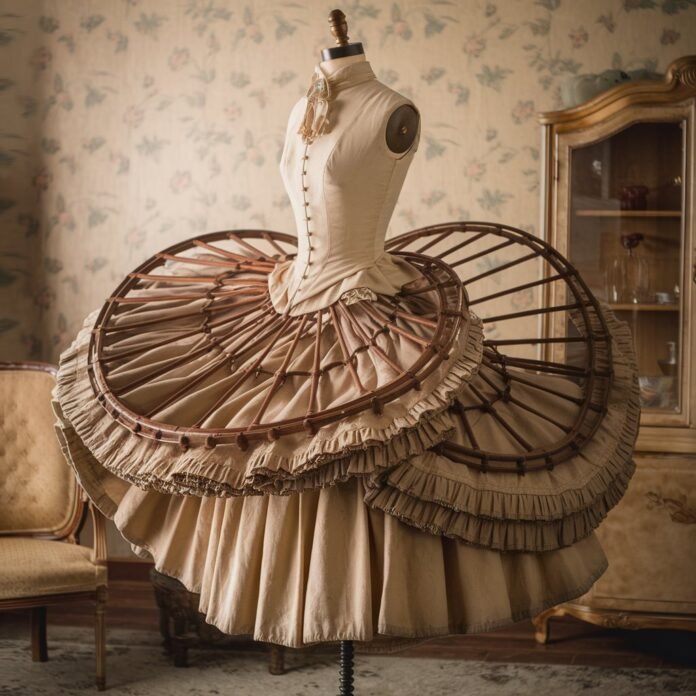Crinoline, a term that may evoke images of voluminous skirts and grand ball gowns, has a storied history in fashion. Originating in the 19th century, this stiff framework worn under skirts became synonymous with the grandeur and elegance of the Victorian era. But crinoline is more than just a historical relic; it has evolved over the years, influencing modern fashion in unexpected ways. This article aims to provide a comprehensive and informative guide to crinoline, exploring its history, evolution, cultural significance, and modern-day applications. By the end of this article, you will have a deep understanding of crinoline and its lasting impact on fashion.
it is a stiff frame worn under a skirt to create a fuller appearance, especially popular in the 19th century.
What is Crinoline?
Crinoline is a type of structured petticoat made from materials like horsehair, cotton, and later, steel hoops. Its primary function was to give skirts a fuller, more voluminous appearance. They were widely popular in the 19th century, especially during the Victorian era. They were often worn under dresses and skirts to create a bell-shaped silhouette, which was the height of fashion at the time.
The Origin of Crinoline
The term “crinoline” is derived from the French words “crin” (meaning horsehair) and “lin” (meaning linen). Originally, crinolines were made from a stiffened fabric that combined horsehair and linen, which was then used to create the desired fullness in women’s skirts. This early version of crinoline was uncomfortable and heavy, but it was a necessary sacrifice for women who wanted to keep up with fashion trends.
Evolution
It has undergone significant changes since its inception. In the mid-19th century, the original fabric-based crinoline was replaced by a more lightweight and flexible version made from steel hoops. This innovation allowed for even greater volume without the discomfort of the earlier versions. The steel hoop crinoline became a staple in women’s fashion and was widely used until the late 19th century.
Cultural Significance
It was more than just a fashion accessory; it was a symbol of social status and wealth. The larger and more elaborate the crinoline, the more affluent the wearer was perceived to be. This association with wealth and status made crinoline a coveted item among women of the time.
However, also had its critics. Some saw it as a symbol of the restrictions placed on women, both physically and socially. The sheer size and volume of crinoline made it difficult for women to move freely, and it was often seen as a reflection of the limitations imposed on women in Victorian society.
Modern Fashion
While longer a staple of everyday fashion, its influence can still be seen in modern designs. Contemporary designers often draw inspiration from the voluminous shapes created by crinoline, incorporating similar elements into their collections. It is also still used in bridal wear, where the desire for a full, dramatic skirt remains popular.
Pop Culture
It has made appearances in various forms of pop culture, from period dramas to fashion shows. It is often used to evoke a sense of nostalgia or to highlight the contrast between modern and historical fashion. In iconic silhouette has also been referenced in various art forms, from paintings to photography.
Making
Creating involves a combination of materials and techniques. Traditionally, crinolines were made from stiffened fabric or steel hoops, but modern versions may use plastic or other lightweight materials. The process of making crinoline involves sewing the material into a series of concentric circles or bands, which are then attached to a waistband or petticoat.
Materials Used
- Horsehair: The original was made from horsehair, which provided the stiffness needed to create volume.
- Linen: Combined with horsehair, linen added strength and durability to the fabric.
- Steel Hoops: Later versions of crinoline used steel hoops to achieve even greater volume and flexibility.
- Plastic: Modern crinolines may use plastic hoops for a lightweight and comfortable alternative.
Process of Making
- Material Selection: The first step in making crinoline is selecting the appropriate materials. Depending on the desired volume and stiffness, different materials may be used.
- Cutting and Shaping: The material is then cut into strips or bands, which are shaped into concentric circles or other desired shapes.
- Assembly: The bands are sewn together and attached to a waistband or petticoat. Additional layers may be added for extra volume.
- Finishing Touches: Finally, the crinoline is finished with decorative elements such as lace or ribbons.
Impact of Fashion History
It has had a lasting impact on fashion, both in its original form and in its modern reinterpretations. The dramatic shapes created by have influenced countless designers, and their cultural significance continues to be explored in various forms of media.
Victorian Era
During the Victorian era, was a symbol of wealth and status. Women who could afford the most elaborate crinolines were seen as the height of fashion, and the larger the crinoline, the more prestigious the wearer was considered.
20th Century
As fashion evolved in the 20th century, crinoline fell out of favor, replaced by more streamlined silhouettes. However, its influence persisted in the form of petticoats and other structured undergarments. Designers continued to draw inspiration from crinoline, using it as a reference point for creating volume and shape in their designs.
Modern Fashion
Today is often used in bridal wear and other special occasion garments. The desire for a full, dramatic skirt remains popular, and crinoline provides the perfect solution. Modern designers also continue to explore the possibilities of crinoline, incorporating it into avant-garde and couture designs.
FAQs
What is the purpose?
it is used to create volume and shape in skirts and dresses. It is typically worn under a garment to give it a fuller appearance.
Still used in fashion today?
Yes, is still used in modern fashion, particularly in bridal wear and special occasion garments. It is also used in couture and avant-garde designs.
What materials are used to make crinoline?
it can be made from various materials, including horsehair, linen, steel hoops, and plastic.
How did crinoline influence fashion history?
it played a significant role in shaping fashion during the Victorian era. It was a symbol of wealth and status and has continued to influence modern fashion.
Why was crinoline controversial?
He was controversial because it restricted women’s movement and was seen by some as a symbol of the limitations placed on women in Victorian society.
Conclusion
More than just a historical garment; it is a symbol of the evolution of fashion and the changing roles of women in society. From its origins in the 19th century to its modern-day reinterpretations, crinoline has left an indelible mark on the fashion world. Its influence can be seen in everything from bridal wear to avant-garde designs, and its cultural significance continues to be explored in various forms of media. Whether you view it as a symbol of elegance or a relic of a bygone era, there is no denying the lasting impact of on fashion history.




